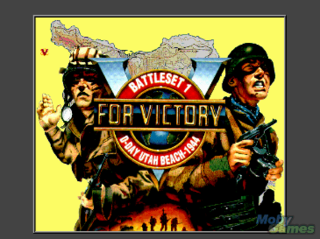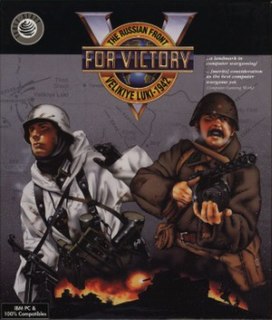
A wargame is a strategy game in which two or more players command opposing armed forces in a realistic simulation of an armed conflict. Wargaming may be played for recreation, to train military officers in the art of strategic thinking, or to study the nature of potential conflicts. Many wargames recreate specific historic battles, and can cover either whole wars, or any campaigns, battles, or lower-level engagements within them. Many simulate land combat, but there are wargames for naval and air combat as well.

The Ancient Art of War is a computer game designed by Dave and Barry Murry, developed by Evryware, and originally published by Broderbund in 1984. It is generally recognized as one of the first real-time strategy or real-time tactics games.

Under Fire! is a tactical level computer game released by Avalon Hill's computer division in 1985. The game was released for Apple II, Commodore 64, and DOS systems. Initial packaging had the name of the designer, Ralph H. Bosson, over the title on the box front so as to read Ralph Bosson's UNDER FIRE!, but subsequent packaging replaced his name and read Avalon Hill's UNDER FIRE! instead. The C64 port was by Dyadic Software Associates.

Tactical wargames are a type of wargame that models military conflict at a tactical level, i.e. units range from individual vehicles and squads to platoons or companies. These units are rated based on types and ranges of individual weaponry. The first tactical wargames were played as miniatures, extended to board games, and they are now also enjoyed as video games.

Command HQ is a real-time strategy world domination game. It was released in 1990 by Microplay Software and was created by designer Danielle Bunten.

Task Force 1942: Surface Naval Action in the South Pacific is an MS-DOS video game released by MPS Labs (MicroProse) in 1992.

Destroyer is a naval combat simulation video game published by Epyx in 1986 for the Amiga, Apple II, Commodore 64, and IBM PC compatibles.

Secret Weapons of the Luftwaffe is a World War II air-combat combat flight simulation game first released in August 1991 by Lucasfilm Games.

Great Naval Battles is a series of computer games by Strategic Simulations which simulate combat between naval vessels. It consist of five separate games, four of which depict various phases of World War II. Each game combines a wider view of the action on a fleet scale, as well as controls for individual ships. SSI covered similar themes in another naval game, Fighting Steel, which was released afterwards, in 1999.

Gary Grigsby's Pacific War is a 1992 strategy wargame released by Strategic Simulations, Inc. It covers World War II in the Pacific between the Japanese Empire and the Allies, which include the United States, the British Empire, the Netherlands, Australia, New Zealand, Canada, the Philippines, and China. The main map of the game stretches from north of the Aleutians to southern New Zealand and Australia, and from the eastern coast of India to the West Coast of North America. It includes aircraft carrier operations, amphibious assaults, surface bombardments/engagements, strategic bombing, kamikazes, and the submarine war against naval and merchant shipping.

Sub Battle Simulator is a naval combat simulation game released by Epyx in 1987. The game was developed by Digital Illusions, Inc. It was released for the Amiga, Apple II, Apple IIGS, Commodore 64, Atari ST, Macintosh, MS-DOS, and the Tandy Color Computer 3.

Decisive Battles of the American Civil War Volume 1: Bull Run to Chancellorsville is a computer wargame developed by Roger Keating and Ian Trout and published by Strategic Studies Group in 1988 for the Commodore 64 and Apple II. Two sequels were released in 1988: Volume 2: Gaines Mill to Chattanooga and Volume 3: Wilderness to Nashville.

The Universal Military Simulator is a computer game developed by Rainbird Software in 1987 for the Apple II, Macintosh, Tandy 4000, and IBM PC compatibles. In 1988 both Atari ST, Amiga versions were released. The game was created by Ezra Sidran. The PC and Amiga versions were ported by Ed Isenberg. The game spawned two sequels: UMS II: Nations at War and The War College: Universal Military Simulator 3.

Harpoon is a computer wargame published by Three-Sixty Pacific in 1989 for DOS. This was the first game in the Harpoon series. It was ported to the Amiga and Macintosh.

V for Victory: D-Day Utah Beach is a 1991 computer wargame developed by Atomic Games and published by Three-Sixty Pacific. It was widely lauded and repeatedly reviewed as the best wargame of its era. Its success led to three further games in the V for Victory series, and then the similar World at War series published by Avalon Hill.

Carriers at War 1941-1945: Fleet Carrier Operations in the Pacific is a 1984 computer wargame by Strategic Studies Group for Apple II and Commodore 64. The game was designed by Roger Keating and Ian Trout. A remake, Carriers at War, was released for DOS in 1992. A sequel to the remake, Carriers at War II, was released for DOS and Mac OS in 1993. A second remake was published by Matrix Games in 2007 for Microsoft Windows.

Fire-Brigade: The Battle for Kiev - 1943 is a computer wargame developed and published by Panther Games in Australia in 1988. The game is set around the historical WWII Eastern Front Battle of Kiev in 1943.

V for Victory: Velikiye Luki is 1992 computer wargame developed by Atomic Games and published by Three-Sixty Pacific. It is part of the V for Victory series.

Carriers at War 1941-1945: Fleet Carrier Operations in the Pacific is a 1992 wargame by Strategic Studies Group for MS-DOS. It's a remake of the 1984 Carriers at War. An expansion pack, Carriers at War: Construction Kit, was released in 1993. A sequel, Carriers at War II, was also released in 1993.

A wargame, generally, is a type of strategy game which realistically simulates warfare. A professional wargame, specifically, is a wargame that is used by military organizations to train officers in tactical and strategic decision-making, to test new tactics and strategies, or to predict trends in future conflicts. This is in contrast to recreational wargames, which are designed for fun and competition.





















